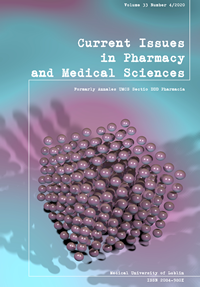Assessment of safety and effectiveness of oral morphine on patients attending pain and palliative care: a study on Indian population
DOI:
https://doi.org/10.2478/cipms-2020-0035Keywords:
palliative care, opioids, pain, morphine, cancer, non cancerAbstract
Opioid analgesics remain the corner stone of effective management of moderate to severe pain. Morphine in its oral and parenteral form is one of the most affordable options left to treat severe cancer pain in most Palliative centres in India. The main objective of our study was to assess the safety and effectiveness, as well as the prescribing pattern of immediate release oral morphine on the Indian population attending Pain and Palliative Care in a multi-speciality hospital. Within the sample population, 74.8% of all patients achieved a pain score reduction of less than or equal to 3 within the 72nd hour. Although the mean baseline pain score was similar in the cancer (8.23±0.75) and the non-cancer (8.26±0.98) group, the mean pain score at the 24th and 72nd hours were significantly different (5.6±1.29 in cancer and 5.09±1.26 in the non-cancer group within the 24th hour, followed by 3.66±1.479 and 3.12±0.88 after the 72nd hour, respectively). The majority of the patients (58.3%) were prescribed at a frequency of 5 mg every 4th hourly, with double dose at bedtime. A similar prescribing trend was seen in both the cancer and non-cancer groups. Moreover, 14 patients underwent dose escalation – with 12 belonging to the cancer group, while 11 patients falling under the cancer group required a switch to different therapy. The major adverse drug reactions (ADR) observed in both study groups were constipation (89.2%), fatigue (37.4%), dry mouth (36%) and nausea/vomiting (23%). The severity of nausea/vomiting and sleepiness was higher in the cancer group whereas itching was more predominant among the non-cancer group.
References
1. Katz N. The impact of pain management on quality of life. J Pain Symptom Manage. 2002;24 (1):S38-S47.
2. Kitzes JA, Domer T. Palliative Care. J Pain Palliat Care Pharmacother. 2004;17 (3):201-10.
3. Palat G, Venkateswaran C. Progress in palliative care in India. Progress in Palliative Care. 2012;20 (4):212-8.
4. Hanks GW, Conno F, Cherny N, Hanna M, Kalso E, McQuay, et al. Morphine and alternative opioids in cancer pain: the EAPC recommendations. Br J Cancer. 2001;84:587-93.
5. Thirlwell MP, Sloan PA, Maroun J, Boos J, Besner JG, Stewart JH, et al. Pharmacokinetics and clinical efficacy of oral morphine solution and controlled-release morphine tablets in cancer patients. Cancer. 1989;63 (11):2275-83.
6. Rajagopal M R, Venkateswaran C. Palliative Care in India: Successes and Limitations. J Pain Palliat Care Pharmacother. 2003;17 (3):121-8.
7. Breivik H, Cherny N, Collet B, de Conno F, Filbert M, Foubert AJ, et al. Cancer - related pain: a pan-European survey of prevalence, treatment, and patientattitudes. Ann Oncol. 2009;20 (8):1420-33.
8. Brown J, Setnik B, Lee K, Cleveland JM, Roland CL, Wase L, et al. Effectiveness and safety of morphine sulfate extended-release capsules in patients with chronic, moderate-to-severe pain in a primary care setting. J Pain Res. 2011;4:373-84.
9. Chou R, Fanciullo GJ, Fine PG, Adler JA, Ballantyne JC, Davies P, et al. Clinical guidelines for the use of chronic opioid therapy in chronic non cancer pain. J Pain. 2009;10 (2):113-30.
10. Penning-van Beest F, van der Haak P, Klok RM, Prevoo YFDM, van der Peet D, Herings RMC. Quality of life in relation to constipation among opioid users. J Med Econ. 2010;13 (1):129-35.
11. Pappagallo M. Incidence, prevalence and management of opioid bowel dysfunction. Am J of Surg. 2001;182 (5):s11-s18.
12. Elumelu T, Abdus Salam A, Soyanwoo O, Adenipekun A. Pattern of morphine prescription by doctors in a Nigeria tertiary hospital. Nigerian J Clin Pract. 2012;15 (1):27-9.
13. Barathi B. Oral morphine prescribing practices in severe cancer pain. Indian J Palliat Care. 2009;15 (2):127.
14. Mercadante S, Berchovich M, Casuccio A, Fulfaro F, Mangione S. A prospective randomized study of corticosteroids as adjuvant drugs to opioids in advanced cancer patients. Am J Hosp Palliat Care. 2007;24 (1):13-9.
15. Schug S, Sidebotham D, McGuinnety M, Thomas J, Fox L. Acetaminophen as an adjunct to morphine by patient-controlled analgesia in the management of acute postoperative pain. Anesth Analg. 1998;87 (2):368-72.
16. Breitbart W. Psychotropic adjuvant analgesics for pain in cancer and AIDS. Psycho‐Oncology. 1998;7 (4):333-45.
17. Watson CP.Antidepressant drugs as adjuvant analgesics. J Pain Symptom Manage. 1994;9 (6):392-405.
18. Reddy S, Patt RB. The benzodiazepines as adjuvant analgesics. J Pain Symptom Manage. 1994;9 (8):510-4.
19. Matoba M. Use of morphine and adjuvant drugs according to the condition. Eur J Pain. 2001;5 (SA):59-62.
20. Patt RB, Proper G, Reddy S. The neuroleptics as adjuvant analgesics. J Pain Symptom Manage. 1994;9 (7):446-53.
21. Caraceni A, Zecca E, Martini C, de Conno F. Gabapentin as an adjuvant to opioid analgesia for neuropathic cancer pain. J Pain Symptom Manage. 1999;17 (6):441-5.
22. Khan MI, Walsh D, Brito-DellanN.Opioid and adjuvant analgesics: compared and contract. Am J Hosp Palliat Care. 2011;28 (5):378-83.
23. Elliott TE, Elliott BA. Physician attitudes and beliefs about use of morphine for cancer pain. J Pain Symptom Manage. 1992;7 (3):141-8.
24. Klepstad P, Rakvag T, Kaas S, Holthe M, Dale O, Borchgrevink PC, et al. The 118 A > G polymorphism in the human mu-opioid receptor gene may increase morphine requirements in patients with pain caused by malignant disease. Acta Anaesthesiol Scand. 2004;48 (10):1232-9.
25. Tywcross R, Miller M. Palliative care. In: Oxford textbook of medicine 4e. Warrell DA, Cox TM, Firth JD (eds). Oxford: Oxford University Press; 2003:1397-407.
26. Cherny N, Ripamonti C, Pereira J, Davis C, Fallon M, McQuay H, et al. Strategies to manage the adverse effects of oral morphine: an evidence-based report. J Clin Oncol. 2001;19 (9):2542-54.
Downloads
Published
Issue
Section
License
Copyright (c) 2021 Authors

This work is licensed under a Creative Commons Attribution-NonCommercial-NoDerivatives 3.0 Unported License.


